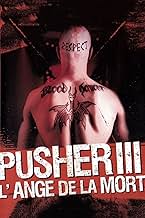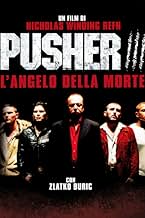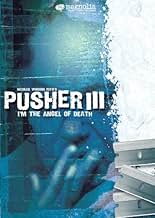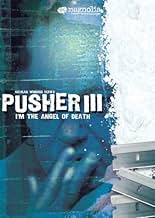Milo tries to be a family man and run his criminal organization, but a wrong drug shipment endangers everything.Milo tries to be a family man and run his criminal organization, but a wrong drug shipment endangers everything.Milo tries to be a family man and run his criminal organization, but a wrong drug shipment endangers everything.
- Director
- Writer
- Stars
Vasilije Bojicic
- Branco
- (as Vanja Bajicic)
- Director
- Writer
- All cast & crew
- Production, box office & more at IMDbPro
Featured reviews
Storyline: 10 years have passed since the first PUSHER movie. Big-time drug dealer Milo (Zlatko Buric) is stressed. Milo attempts to quit heroin by attending Narcotics Anonymous meetings, a shipment supposed to contain brown heroin turns out to contain 10.000 ecstasy-pills, and it's his daughter Milena's (Marinela Dekic) 25th birthday, and Milo has promised to cook food for her 50 guests. Little Muhammed (Ilyas Agac) leaves with the ecstasy-pills to sell them for Milo, but soon Milo can't find him, and the Albanian-Danish gangsters who smuggled the ecstasy-pills into Denmark are stressing Milo for their money. Conidentially Milo meets Kusse-Kurt (Kurt Nielsen) who slips him a small amount of heroin. Soon Milo's finds himself in a spiral of bad decisions smoking heroin, sniffing speed and murdering gangsters. Is Milo's drug empire finally crumbling?
Each installment of Nicolas Winding Refn's docu-drama trilogy tells a story from Copenhagen's underworld, but from three completely different protagonists' POV's. PUSHER tells the story of middle-level pusher Frank (Kim Bodnia), PUSHER 2 tells the story of low-level criminal Tonny (Mads Mikkelsen), and PUSHER 3 tells the story of high-level pusher Milo (Zlatko Buric). The clear message of the trilogy is: you live by the sword, you die by the sword. All three movies end on very ambivalent notes. Frank gets killed... or perhaps he doesn't. Tonny breaks loose of his dead-end lifestyle... or perhaps he doesn't. And Milo's drug empire crumbles... or perhaps it doesn't. That's how life is. It doesn't just stop. Each movie keeps evolving in your head even after they've ended, similar to John Cassavetes' movies or Danny Boyles' 1996 masterpiece TRAINSPOTTING. It's certainly something one doesnn't experience in braindead Hollywood blockbusters nowadays.
Nicolas Winding Refn's PUSHER trilogy is obviously inspired by John Cassevetes' movie-making style as they are more instinctive than intellectual, because the audience goes through the same turbulent emotions as Milo, whether it's melancholy, joy or bitterness. It's not a very fast-paced movie (except for a few breath-taking scenes), but Refn manages to maintain an uneasy tension that keeps the audience on the edge of the seats. It reflects Refn's love for his (three-dimensional) characters. Refn's 95% non-Danish dialog (the cast mainly consists of immigrants) is somewhere in-between Quentin Tarantino and John Cassavetes: very self-conscious, yet also natural and realistic. The foreign languages only adds to the mysteriousness and danger of these immigrant gangsters.
The cast primarily consists of unprofessional actors, some even with semi-criminal backgrounds, and, naturally the great Zlatko Buric whom Refn has called "the new Dirch Passer". Buric brilliantly brings out Milo's two-face ambivalence and vulnerability of an aging man in a constantly changing milieu. Refn gets performances from the unprofessional cast that range from acceptable to great -- they all add to the realness and authenticity. Many of them, of course, more or less play their real life-themselves. Many of the PUSHER characters keep re-occurring throughout the trilogy. For example: Milo (Zlatko Buric) has a supporting-role in PUSHER, a cameo-role in PUSHER 2 and the main-role in PUSHER 3. Tonny (Mads Mikkelsen) has a supporting-role in PUSHER and the main-role in PUSHER 2. Kusse-Kurt (Kurt Nielsen) has a supporting-role in PUSHER 2 and a cameo-role in PUSHER 3. This provides a feeling of continuity to the trilogy's milieu.
Peter Peter (ex-member of the legendary Danish rock-group Sort Sol) has again composed the music in collaboration with Kyed. Although I preferred the 80's-synth-inspired score in PUSHER 2, this time it's effective, bleak and minimal. For example: When Kusse-Kurt slips Milo a small amount of heroin in the grill-bar, shortly after a disturbing, noisy, distorted guitar-riff begins clashing repeatedly with 4 second intervals. It underlines Milo's desperate mind-state. One minute later Milo walks into the restroom to smoke the heroin, where the clashing guitar sound slowly transforms into a beautiful, melancholic piano-tune to underline the heroin's effect on Milo. It's a good example of subtle use of music as a movie-language.
Refn's love for so-called trashy genre-flicks shows through-out his work. Although his movies (the PUSHER trilogy, BLEEDER and FEAR X) are more art-house than genre-pieces, they are loaded with references to his favorite obscure movies, most noticeably in BLEEDER. But also PUSHER 3 contains a subtle reference, probably not known to most audiences. The climax-scene in-which Radovan (Slavko Labovic) slices up the body hanging form the ceiling is an obvious homage to one of Refn's favorite-movies Paul Morrissey's FLESH FOR FRANKENSTEIN from 1973 starring Udo Kier. FLESH FOR FRANKENSTEIN is a an original twist on the Frankenstein franchise with necrophiliac undertones. Refn borrows his climax from the climax of FLESH FOR FRANKENSTEIN: the music, the chains slowly pulling the body up, the depraved depiction of human-flesh etc. As they say, the best directors borrow from their favorite-directors.
Although all three installment are semi-masterpieces I personally prefer PUSHER 3 by a few inches. It's more honest, more disturbing, and more experimental. I have experienced the first-mentioned first-hand, as I spend years in the drug milieu. Refn's PUSHER trilogy is a street-level counterpart to Martin Scorsese's gangster trilogy (consisting of MEAN STREETS from 1973, GOODFELLAS from 1990, and CASINO from 1995), because both trilogies portray the crime underworld from low-level, middle-level and high-level gangsters' POV's. I highly recommend PUSHER 3 especially if you enjoyed its successors, although, the re-occurring characters aside, it's not completely necessary to watch the prequels before experiencing this gem, but I recommend doing so. Watch it! 9/10
Each installment of Nicolas Winding Refn's docu-drama trilogy tells a story from Copenhagen's underworld, but from three completely different protagonists' POV's. PUSHER tells the story of middle-level pusher Frank (Kim Bodnia), PUSHER 2 tells the story of low-level criminal Tonny (Mads Mikkelsen), and PUSHER 3 tells the story of high-level pusher Milo (Zlatko Buric). The clear message of the trilogy is: you live by the sword, you die by the sword. All three movies end on very ambivalent notes. Frank gets killed... or perhaps he doesn't. Tonny breaks loose of his dead-end lifestyle... or perhaps he doesn't. And Milo's drug empire crumbles... or perhaps it doesn't. That's how life is. It doesn't just stop. Each movie keeps evolving in your head even after they've ended, similar to John Cassavetes' movies or Danny Boyles' 1996 masterpiece TRAINSPOTTING. It's certainly something one doesnn't experience in braindead Hollywood blockbusters nowadays.
Nicolas Winding Refn's PUSHER trilogy is obviously inspired by John Cassevetes' movie-making style as they are more instinctive than intellectual, because the audience goes through the same turbulent emotions as Milo, whether it's melancholy, joy or bitterness. It's not a very fast-paced movie (except for a few breath-taking scenes), but Refn manages to maintain an uneasy tension that keeps the audience on the edge of the seats. It reflects Refn's love for his (three-dimensional) characters. Refn's 95% non-Danish dialog (the cast mainly consists of immigrants) is somewhere in-between Quentin Tarantino and John Cassavetes: very self-conscious, yet also natural and realistic. The foreign languages only adds to the mysteriousness and danger of these immigrant gangsters.
The cast primarily consists of unprofessional actors, some even with semi-criminal backgrounds, and, naturally the great Zlatko Buric whom Refn has called "the new Dirch Passer". Buric brilliantly brings out Milo's two-face ambivalence and vulnerability of an aging man in a constantly changing milieu. Refn gets performances from the unprofessional cast that range from acceptable to great -- they all add to the realness and authenticity. Many of them, of course, more or less play their real life-themselves. Many of the PUSHER characters keep re-occurring throughout the trilogy. For example: Milo (Zlatko Buric) has a supporting-role in PUSHER, a cameo-role in PUSHER 2 and the main-role in PUSHER 3. Tonny (Mads Mikkelsen) has a supporting-role in PUSHER and the main-role in PUSHER 2. Kusse-Kurt (Kurt Nielsen) has a supporting-role in PUSHER 2 and a cameo-role in PUSHER 3. This provides a feeling of continuity to the trilogy's milieu.
Peter Peter (ex-member of the legendary Danish rock-group Sort Sol) has again composed the music in collaboration with Kyed. Although I preferred the 80's-synth-inspired score in PUSHER 2, this time it's effective, bleak and minimal. For example: When Kusse-Kurt slips Milo a small amount of heroin in the grill-bar, shortly after a disturbing, noisy, distorted guitar-riff begins clashing repeatedly with 4 second intervals. It underlines Milo's desperate mind-state. One minute later Milo walks into the restroom to smoke the heroin, where the clashing guitar sound slowly transforms into a beautiful, melancholic piano-tune to underline the heroin's effect on Milo. It's a good example of subtle use of music as a movie-language.
Refn's love for so-called trashy genre-flicks shows through-out his work. Although his movies (the PUSHER trilogy, BLEEDER and FEAR X) are more art-house than genre-pieces, they are loaded with references to his favorite obscure movies, most noticeably in BLEEDER. But also PUSHER 3 contains a subtle reference, probably not known to most audiences. The climax-scene in-which Radovan (Slavko Labovic) slices up the body hanging form the ceiling is an obvious homage to one of Refn's favorite-movies Paul Morrissey's FLESH FOR FRANKENSTEIN from 1973 starring Udo Kier. FLESH FOR FRANKENSTEIN is a an original twist on the Frankenstein franchise with necrophiliac undertones. Refn borrows his climax from the climax of FLESH FOR FRANKENSTEIN: the music, the chains slowly pulling the body up, the depraved depiction of human-flesh etc. As they say, the best directors borrow from their favorite-directors.
Although all three installment are semi-masterpieces I personally prefer PUSHER 3 by a few inches. It's more honest, more disturbing, and more experimental. I have experienced the first-mentioned first-hand, as I spend years in the drug milieu. Refn's PUSHER trilogy is a street-level counterpart to Martin Scorsese's gangster trilogy (consisting of MEAN STREETS from 1973, GOODFELLAS from 1990, and CASINO from 1995), because both trilogies portray the crime underworld from low-level, middle-level and high-level gangsters' POV's. I highly recommend PUSHER 3 especially if you enjoyed its successors, although, the re-occurring characters aside, it's not completely necessary to watch the prequels before experiencing this gem, but I recommend doing so. Watch it! 9/10
I found Pusher Three the best of the trilogy and would strongly disagree with anyone who bashes on this film. Of course, what makes the Pusher movies great is how realistic the scenarios are. Unlike Tarintino, who's dialog is tricky, sometimes too tricky, the Pusher films have simple, believable dialog. Similair to The Sapranos, Pusher III's appeal is seeing the personal life of gangsters. Milo is a chef and restaurant owner but a drug dealer behind the scenes. Its great seeing Milo go back and fourth between preparing a fifty person meal for his daughters 25th Birthday and settling a drug deal in the back room. A great movie that shows you the stress of a gangster trying to maintain his status as a family man. Milo is one of my favorite movie drug dealers. If your not into drugs, you probably won't appreciate all the minor details of the Pusher trilogy.
This film is a portrait of a gangster boss. We witness the downfall of the once so cool and untouchable Milo that we got to know in the first Pusher film. Milo is trying to maintain his position in the competitive dopemarket of Copenhagen, but times are changing and younger generations are taking over. On top of this, Milo is trying to quit using dope himself and is attending meetings in Narcotics Anonymous, and he is trying to be a good father to his daughter and make her birthday party a good one.
Nicolas Winding Refn has a way of making my stomach twist and turn like no other director. I can watch gore and splatter films no problem, but the cold and cynical violence in the Pusher gets to me, because it is set in a, for me, very realistic environment. I'm not sure that I like it, but one thing is for sure; it works. The character descriptions are, as always, very believable. The mixing of a lot of the different languages of the different gangs is a funny feature, that I like. Technically, the hand-held camera works okay, but it's not the best. Music and lighting effects are great.
The film is not as good as the first Pusher film, but it has its moments, Zlatko Buric is enjoyable every second, gore is for gore-lovers, the Pusher "mood" is there and it is a fine ending of a remarkable and original trilogy that the danish film scene can be proud of.
Nicolas Winding Refn has a way of making my stomach twist and turn like no other director. I can watch gore and splatter films no problem, but the cold and cynical violence in the Pusher gets to me, because it is set in a, for me, very realistic environment. I'm not sure that I like it, but one thing is for sure; it works. The character descriptions are, as always, very believable. The mixing of a lot of the different languages of the different gangs is a funny feature, that I like. Technically, the hand-held camera works okay, but it's not the best. Music and lighting effects are great.
The film is not as good as the first Pusher film, but it has its moments, Zlatko Buric is enjoyable every second, gore is for gore-lovers, the Pusher "mood" is there and it is a fine ending of a remarkable and original trilogy that the danish film scene can be proud of.
The director Nicolas Winding Refn once again delivers a day of total agony and disaster. This day is almost as well presented as Frank's day in Pusher and gives you a look inside the life of a junkie, psychopath and father; Milo the drug-dealer.
Although the entire movie feels slow-paced there are few movies which will leave you as stunned and with such an ugly feeling inside your stomach. This one is truly merciless in it's presentation of the criminal world in Copenhagen, and globally, where nothing is tabu and everyone lives by a code as dark as charcoal.
This deterioration of gangster and his respect is a truly scary journey filled with disappointment, failure and death.
Although the entire movie feels slow-paced there are few movies which will leave you as stunned and with such an ugly feeling inside your stomach. This one is truly merciless in it's presentation of the criminal world in Copenhagen, and globally, where nothing is tabu and everyone lives by a code as dark as charcoal.
This deterioration of gangster and his respect is a truly scary journey filled with disappointment, failure and death.
'The third part of Nicolas Winding Refn's Pusher trilogy is clearly the best. With each part, Refn's approach becomes more daring and complex. However talented his debut from 1996 was, and however innovative the second part, this third part has a charged emotionalism that is difficult to beat, along with tension and courage. I'm the Angel of Death - Pusher III focuses on the Serbian drugs baron Milo. In earlier parts, he was an extra, a feared power lurking in the background. He is not some grand godfather, and as a middle-ranking boss he has also been on the decline for some time, yet he should not be underestimated as an adversary. At first, he seems to allow himself to be trifled with. His spoiled daughter is very demanding in everything on her birthday. His gangster sidekicks have been put out of action by food poisoning - as a result of Milo's cooking. Albanian crooks cheekily try to take over his dealing turf. He obediently attends meetings of Addicts Anonymous, afraid of returning to his old ways. But don't trifle with Milo. Or you will come to a bloody end. With his trilogy, and certainly with this last part, Refn has not only succeeded in renewing the gangster genre, but also providing it with a new geography. The American mean streets have been convincingly replaced by the multi-ethnic pavements of a Europe that has not yet been given the profile it deserves.'
quoted from: film festival Rotterdam (2006), GJZ
I couldn't agree more. Go see this film. Sharing 'downfall' as the central theme, it's better than Scarface and even more realistic about non-Hollywood gangster life than the Sopranos.
quoted from: film festival Rotterdam (2006), GJZ
I couldn't agree more. Go see this film. Sharing 'downfall' as the central theme, it's better than Scarface and even more realistic about non-Hollywood gangster life than the Sopranos.
Storyline
Did you know
- TriviaIt was because of the criticism this film recieved in Denmark that Nicolas Winding Refn decided to stop making films there.
- GoofsWhen Milo is speaking at his daughters birthday party, the type of glass he is holding changes twice.
- ConnectionsFeatured in NWR (Nicolas Winding Refn) (2012)
- How long is Pusher III?Powered by Alexa
Details
- Release date
- Country of origin
- Official sites
- Languages
- Also known as
- I'm the Angel of Death: Pusher III
- Filming locations
- Production companies
- See more company credits at IMDbPro
Box office
- Gross US & Canada
- $1,605
- Opening weekend US & Canada
- $1,792
- Aug 20, 2006
- Gross worldwide
- $1,605
- Runtime1 hour 48 minutes
- Color
- Sound mix
- Aspect ratio
- 1.85 : 1
Contribute to this page
Suggest an edit or add missing content




























